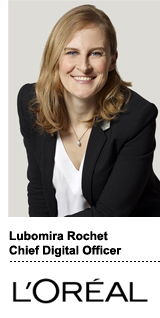
L’Oreal doesn’t like the word “programmatic.”
“We prefer ‘precision marketing,’” said Lubomira Rochet, L’Oreal’s chief digital officer.
Precision, Rochet said, is about something deeper than targeting or frequency capping or the sequencing of messages. While important, those are tactics, not the cornerstones of a strategy.
“But precision advertising goes beyond programmatic,” she said. “For us, it’s not about where or how we buy, it’s about the strategy.”
Around 2010, L’Oreal embarked on what’s become an ongoing process of self-reflection and digital transformation. Over the years, the multinational French cosmetics brand has hired more than 1,400 digital-focused employees, opened a research and tech incubator in San Francisco and launched an accelerator for early-stage beauty startups.
Today, digital constitutes more than 35% of L’Oreal’s overall media investment. More than 1 billion people visit L’Oreal sites and social pages every year.
There’s still more to do, though, Rochet said.
“We’re only in the midst of the first phase of putting digital at the center and at the heart of all we do,” she said. “We’re constantly evolving.”
AdExchanger spoke with Rochet about consumer data, beauty tech innovation and why digital transformation never ends.
AdExchanger: How does your role dovetail with L’Oreal marketing chiefs across the globe?
LUBOMIRA ROCHET: I’m in charge of the digital transformation groups and report directly to the CEO. We don’t have a CMO at L’Oreal, but rather local CMOs that report to me and to their VP of country.
What does it mean to be in charge of digital transformation?
My four main focuses are ecommerce, digital marketing, including digital media, innovation and services. When I arrived four years ago, my job became to strategize, scale and accelerate the transformation.
Consumers in digital beauty are buying more online, which is why our first pillar is ecommerce. We had $1.7 billion in online sales last year.
We are also working to reinvent the marketing model to create more of a balance between what we call precision marketing, accelerating our content production and influencer strategy and reinforcing the digital consumer experience with services like AR skincare and virtual makeup try-on.
These four pillars are being adapted to every country, but the strategy remains the same.
When is digital transformation complete, or is it an open-ended, ongoing process?
Digital transformation happens in stages. The purpose is for all of our people to be able to put digital first. We deeply believe that we’re not doing digital marketing, we’re marketing in a digital age. Part of this is being super-agile to see new trends, connecting with startups across the world and integrating new technology, including AR and VR, into the consumer experience wherever it makes sense.
What consumer data is valuable to L’Oreal?
Obviously, first-party is important to us because it helps us understand our consumer better. Our direct-to-consumer websites and our media brings us a lot of data, all of which is a proxy for consumer knowledge. We also get data from services like our Genius app [for virtual makeup testing]. And we partner with media companies, publishers and retailers for access to relevant second-party data.
Who are your most valuable ad tech partners?
We, of course, use all of the platforms that give us access to retargeting and lookalike audiences, like Facebook, and Alibaba and Tencent in China.
Beauty products are personal, often more so than most other CPG products. How does L’Oreal approach personalization?
Take skincare. Sometimes men or women don’t know what their skincare problems are and they rely on us, our content and our services to recommend the right routine and the right product.
For example, we launched something called the “connected brush” with a partner earlier this year. Every time you brush your hair, a sensor in the brush detects the level of hydration on your scalp, how conditioned the hair is and the number of hairs you lose. We can use that information to personalize a product recommendation and advice for your exact condition. That is the type of personalization we strive for.
How does L’Oreal stay ahead of the digital native upstarts crowding into the cosmetics space?
We learn from these brands and we get inspired. L’Oreal has 35 international brands and operates in 65 countries – we know scale. But these brands can teach us so much.
Look at NYX Professional Makeup, a cosmetics brand that we acquired [in 2014]. Our CEO [John Paul Agon] recently said that the acquisition was more than us “L’Oreal-ifying” NYX, but rather that they “NYX-ified” us.
We bring them scale and best practices and they bring us innovation.
This post was syndicated from Ad Exchanger.

More Stories
M+AD takes break for Anzac Day commemoration
Sustainability Is More Than a Big Leafy Green Picture
Google Won’t Pull Cookies In 2024